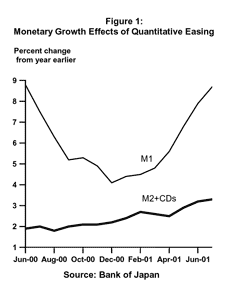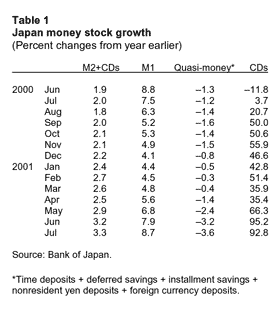In the wake of continued weakness in the Japanese economy and recent market turbulence due to the terrorist attacks in the U.S., the Bank of Japan (BOJ) recently increased the intensity of its quantitative easing program, which it had begun in March of this year. The BOJ initially switched from the usual approach to expansionary monetary policy—namely, a reduction in the target short-term interest rate—to quantitative easing because by that time it had been pursuing a target very close to zero (0.15%).
- Quantitative easing, unsterilized intervention, and the liquidity trap
- Exceptions
- Conclusion
- References
Pacific Basin Notes. This series appears on an occasional basis. It is prepared under the auspices of the Center for Pacific Basin Monetary and Economic Studies within the FRBSF’s Economic Research Department.
In the wake of continued weakness in the Japanese economy and recent market turbulence due to the terrorist attacks in the U.S., the Bank of Japan (BOJ) recently increased the intensity of its quantitative easing program, which it had begun in March of this year. The BOJ initially switched from the usual approach to expansionary monetary policy—namely, a reduction in the target short-term interest rate—to quantitative easing because by that time it had been pursuing a target very close to zero (0.15%). The BOJ argued that, at an interest rate so close to zero, further nominal interest rate target reductions were constrained to be small, as under normal circumstances nominal interest rates are bounded at zero. As a result, the possible stimulus obtained through further reduction in the interest rate target was likely to be limited.
Under quantitative easing, the BOJ conducts open market operations aimed at increasing the money supply and reducing long-term interest rates. The recent intensification of the program has come in a number of forms. The increase in quantitative easing involves the BOJ engaging in open market transactions aimed at increasing its balance of current bank accounts held at the BOJ. Balances were initially increased from 5 trillion yen to 6 trillion yen. After September 11, 2001, balances rose as high as 12.5 trillion yen, but the BOJ gradually brought balances back down to 7 trillion yen a month later. In addition, the BOJ announced that it would increase its outright purchase of long-term government bonds from 400 billion yen per month to 600 billion yen per month. Finally, the BOJ also intervened against the dollar; while the BOJ has intervened repeatedly recently against the rising yen, the latest intervention was notable because it was unsterilized, meaning that the central bank allowed the intervention to increase the money supply.
In this Economic Letter, I examine the prospects for these strategies in an environment where nominal rates are close to zero. I argue that, in this environment, a modest expansion in the growth rate of the money supply is likely to have a limited expansionary impact unless it is accompanied by the public’s expectation of higher future inflation rates. And neither quantitative easing nor unsterilized intervention against the yen is likely to change inflation expectations. However, insofar as BOJ open market purchases of long-term government debt raise the price of these assets, they also may lower the yield. At the same time, other factors that influence long-term nominal rates, such as inflation expectationsand risk premia, may mitigate the downward impact of these purchases.
Quantitative easing, unsterilized intervention, and the liquidity trap
An economy is said to be in a liquidity trap when nominal interest rates on short-term assets have been driven to zero. Thus, nominal interest rates can fall no farther, because currency yields zero nominal interest and is the most desirable asset for other functions, such as engaging in transactions.
Because nominal interest rates cannot be negative, one might conclude that, once nominal rates are equal to zero, further monetary expansion of any sort is impossible. For example, consider the prospects for quantitative easing at a zero nominal rate. The BOJ prints money (or issues reserves) and purchases short-term government securities from a bank.

What would the effects of such a transaction be? Because of the zero lower bound, nominal interest rates are unchanged. In addition, the bank has additional currency and a smaller stock of government securities. From the bank’s point of view, it has swapped a near-zero interest rate asset on its balance sheet (short-term government securities) for a zero interest rate asset (currency or reserves). The bank may therefore consider these two assets as being close to interchangeable. As a result, the open market transaction has failed to change the balance sheet status of the bank in a tangible way and, hence, may have no impact on its lending activity.
Such a scenario appears to match roughly the experience Japan has had with quantitative easing since its inception in March 2001. Figure 1 illustrates that the quantitative easing strategy that the BOJ began in March has succeeded in reversing the decline in growth of M1, a narrow money aggregate. However, broader monetary aggregates, such as the M2+CDs aggregate that the BOJ follows most closely, have responded quite modestly.

The source of this discrepancy is shown in Table 1, which displays the growth experiences of the components of the broader M2+CDs aggregate. While M1 has indeed enjoyed robust positive growth since the inception of the quantitative easing strategy, there has been a matching decline in the aggregate known as “quasi-money,” which includes time deposits and a number of other less liquid assets. While the central bank can increase the stock of narrow money in the economy, the banks appear to be treating the exercise much like a swap of near-zero and zero interest rate assets, and they are responding with little change in their lending activities.
The story with unsterilized foreign exchange intervention may be similar. Consider an unsterilized intervention where the BOJ purchases dollar assets with newly printed money. If Japanese and domestic assets are perfect substitutes, the situation is basically the same as a domestic open market operation. For example, suppose that a Japanese bank swapped a foreign asset in its portfolio for the Japanese currency. This would leave the foreign bank with a change in asset composition (it now has fewer foreign assets and more domestic assets), but if these assets are perfect substitutes, there would be no substantive change in its balance sheet. As in the domestic quantitative easing, the operation may have no impact on the bank’s lending pattern.
Under the proper conditions, quantitative easing may still have real effects. Consider the impact of the open market transaction discussed above in the context of the real, rather than the nominal, rate of interest. The real rate of interest is defined as the nominal rate of interest minus expected inflation, and it reflects the true expected return on an asset.
If the money injection raises expected future interest rates, it can lead to a negative real interest rate. Unlike the zero lower bound on nominal rates, there is no such barrier on real rates. In particular, when expected future inflation is positive, currency earns a negative rate of return. This implies that it is now costly for banks to hold currency on their balance sheets. In this environment, banks would respond to a monetary injection by attempting to remove zero nominal return assets from their balance sheets. This would be achieved by expanding their lending activities.
But can inflationary expectations be affected by the monetary injection itself? As discussed above, it is possible that the expanded money stock could stay on the books of the banks, resulting in no expansion of the economy, and confirming the banks’ expectations of a continued zero nominal rate. To break the liquidity trap, then, it would appear to be necessary for the central bank to convince the public that such a zero nominal rate will not persist. It is unclear whether incremental increases in the money growth rate can have that effect.
This is the primary reason why a number of prominent economists and Japanese public officials are arguing for the BOJ to adopt an explicit inflation-targeting regime. They argue that if the central bank announced that it would continue its policy of monetary expansion until it achieved its inflation target, it could influence public expectations and thereby influence the real rate of interest. However, some argue that the announcement of an inflation target alone does not guarantee its achievement, particularly in the absence of current inflation (see Spiegel 2001).
Leaving aside other arguments for or against explicit inflation targets, it is unclear whether explicit inflation targets are necessary to reduce the real interest rate. Solely in terms of influencing public opinion, the BOJ may achieve the goal of escaping the liquidity trap by announcing that it will continue to pursue expansionary monetary policy until deflation is eradicated. If the announcement were credible, the public would be uncertain about the future inflation rate, but it would hold a positive expected rate, which would be sufficient to yield a negative real interest rate at zero nominal rates.
It appears that the BOJ is moving towards such a stance. BOJ Governor Hayami recently stated that the central bank would “…do its best to tame deflationary pressures” (Nihon Keizai Shimbun 2001). Such a statement appears to suggest a willingness to continue expansionary monetary policy until deflation is eradicated without moving towards the adoption of an explicit inflation-targeting regime.
If assets are imperfectly substitutable, other possibilities arise. For example, under imperfect asset substitutability, the public would respond to a BOJ purchase of long-term assets by increasing their relative price. This increase in the price of the long-term asset implies a reduction in the long-term interest rate. Since long-term interest rates are positive, the liquidity trap issues discussed above do not arise.
Similarly, under imperfect asset substitutability, a purchase of foreign assets would leave Japanese assets relatively less scarce, driving down their price, and hence the relative value of the yen. This decrease in the value of the yen raises the price of goods in yen and, therefore, reduces the real interest rate through increased inflation expectations.
The data provide little evidence that the new steps taken by the BOJ are having far greater effects than previous efforts. There has been little downward pressure on long-term nominal rates in Japan since the inception of the quantitative easing program. Indeed, the yield on 10-year Japanese government securities has generally risen from the 1.15% levels that prevailed in mid-March 2001 when the policy was adopted to 1.355%. While it is impossible to know what the long-term rate would have been in the absence of the BOJ purchases, it appears that the purchases have had little impact on long-term rates.
The yen/dollar exchange rate has also continued to appreciate, suggesting that unsterilized foreign exchange intervention has not been effective. However, in light of recent turmoil in the United States, it is also possible that the exchange rate appreciation would have been more dramatic in the absence of the BOJ’s intervention.
Mark Spiegel
Research Advisor
Nihon Keizai Shimbun. 2001. “BOJ Governor Gives Nod to Koizumi’s Reform Agenda” (August 31).
Spiegel, Mark M. 2000. “Inflation Targeting for the Bank of Japan?” 00-11 (April 7). /economic-research/wklyltr/2000/el2000-11.html
Opinions expressed in FRBSF Economic Letter do not necessarily reflect the views of the management of the Federal Reserve Bank of San Francisco or of the Board of Governors of the Federal Reserve System. This publication is edited by Anita Todd and Karen Barnes. Permission to reprint portions of articles or whole articles must be obtained in writing. Please send editorial comments and requests for reprint permission to research.library@sf.frb.org